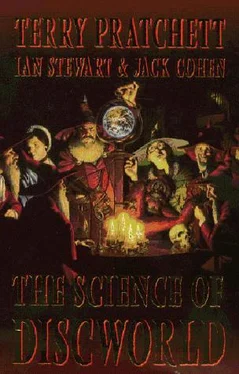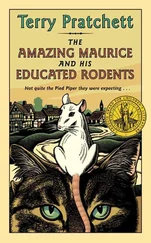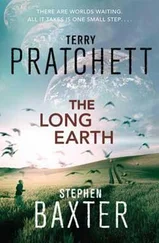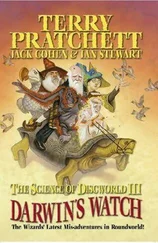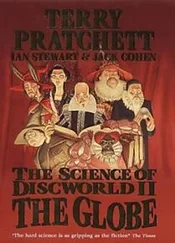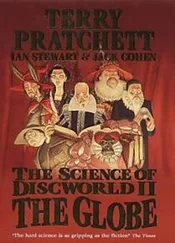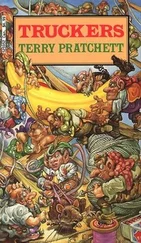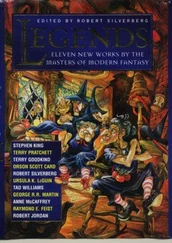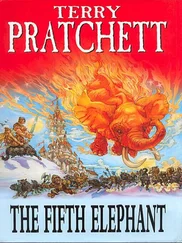Terry Pratchett - The Science of Discworld I
Здесь есть возможность читать онлайн «Terry Pratchett - The Science of Discworld I» весь текст электронной книги совершенно бесплатно (целиком полную версию без сокращений). В некоторых случаях можно слушать аудио, скачать через торрент в формате fb2 и присутствует краткое содержание. Жанр: Фантастика и фэнтези, на английском языке. Описание произведения, (предисловие) а так же отзывы посетителей доступны на портале библиотеки ЛибКат.
- Название:The Science of Discworld I
- Автор:
- Жанр:
- Год:неизвестен
- ISBN:нет данных
- Рейтинг книги:5 / 5. Голосов: 1
-
Избранное:Добавить в избранное
- Отзывы:
-
Ваша оценка:
- 100
- 1
- 2
- 3
- 4
- 5
The Science of Discworld I: краткое содержание, описание и аннотация
Предлагаем к чтению аннотацию, описание, краткое содержание или предисловие (зависит от того, что написал сам автор книги «The Science of Discworld I»). Если вы не нашли необходимую информацию о книге — напишите в комментариях, мы постараемся отыскать её.
The Science of Discworld I — читать онлайн бесплатно полную книгу (весь текст) целиком
Ниже представлен текст книги, разбитый по страницам. Система сохранения места последней прочитанной страницы, позволяет с удобством читать онлайн бесплатно книгу «The Science of Discworld I», без необходимости каждый раз заново искать на чём Вы остановились. Поставьте закладку, и сможете в любой момент перейти на страницу, на которой закончили чтение.
Интервал:
Закладка:
There are plenty of details to Darwinism that still aren't understood, as with all science, but most of the obvious ways of trying to shoot it down have been answered effectively. The classic example -still routinely trotted out by creationists and others even though Darwin himself had a pretty good answer, is the evolution of the eye. The human eye is a complex structure, and all of its components have to fit together to a high degree of accuracy, or it won't work. If we claim that such a complex structure has evolved, we must accept that it evolved gradually. It can't all have come into being at once. But if so, then at every stage along the evolutionary track the still-evolving proto-eye must offer some kind of survival advantage to the creature that possesses it. How can this happen? The question is often asked in the form 'What use is half an eye?', to which you are expected to conclude 'nothing', followed by a rapid conversion to some religion or other. 'Nothing' is a reasonable answer, but to the wrong question. There are lots of ways to get to an eye gradually that do not require it to be assembled piece by piece like a jigsaw puzzle. Evolution does not build creatures piece by piece like the God of Evolution in The Last Continent. Darwin himself pointed out that in creatures alive in his day you could find all kinds of light-sensitive organs, starting with patches of skin, then increasing in complexity, light-gathering power, and ability to detect fine detail, right up to structures as sophisticated as the human eye. There is a continuum of eyelike organs in the living world, and every creature gains an advantage by having its own type of light-sensing device, in comparison to similar creatures that have a slightly less effective device of a similar kind.
In 1994 Daniel Nilsson and Susanne Pelger used a computer to see what would happen to a mathematical model of a light-sensing surface if it was allowed to change in small, random, biologically feasible ways, with only those changes that improved its sensitivity to light being retained. They found that within 400,000 generations, an evolutionary blink of an eye, that flat surface gradually changed into a recognizable eye, complete with a lens. The lens even bent light differently in different places, just like our eye and unlike normal spectacle lenses. At every tiny step along the way, a creature with the improved 'eye' would be better than those with the old version.
At no stage was there ever 'half an eye'. There were just light-sensing things that got better at it.
Since the 1950s, we have been in possession of a new and central piece of the evolutionary jigsaw, one that Darwin would have given his right arm to know about. This is the physical, more precisely, chemical, nature of whatever it is that ensures that characteristics of organisms can change and be passed from one generation to the next.
You know the word: gene.
You know the molecule: DNA.
You even know how it works: DNA carries the genetic code, a kind of chemical 'blueprint' for an organism.
And, probably, a lot of what you know is lies-to-children.
Just as 'survival of the fittest' captured the imaginations of the Victorians, so 'DNA' has captured the imaginations of today's public. However, imaginations thrive best if they are left free to roam: they grow tired and feeble in captivity. Captive imaginations do breed quite effectively, because they are protected from the terrible predator known as Thought.
DNA has two striking properties, which play a significant role in the complex chemistry of life: it can encode information, and that information can be copied. (Other molecules process the DNA information, for example by making proteins according to recipes encoded in DNA.) From this point of view a living organism is a kind of molecular computer. Of course there's much more to life than that, but DNA is central to any discussion of life on Earth. DNA is life's most important molecular-level 'space elevator', a platform from which life can launch itself into higher realms.
The complexity of living creatures arises not because they are made from some special kind of matter- the now-discredited 'vitalist' theory, but because their matter is organized in an exceedingly intricate fashion. DNA does a lot of the routine 'bookkeeping' that keeps living creatures organized. Every cell of (nearly) every living organism contains its 'genome', a kind of code message written in DNA, which gives that organism a lot of hints about how to behave at the molecular level. (Exceptions are various viruses, on the boundary between life and non-life, which use a slightly different code.)
This is why it was possible to clone Dolly the Sheep, to take an ordinary cell from an adult sheep and make it grow into another sheep. The trick actually requires three adult sheep. First, there's the one from which you take the cell: call her 'Dolly's Mum'. Then you persuade the cell's nucleus to forget that it came from an adult and to think that it's back in the egg, and then you implant it into an egg from a second sheep ('Egg Donor'). Then you put the egg into the uterus of the third sheep ('Surrogate Mum') so that it can grow into a normal lamb.
Dolly is often said to be a perfect copy of Dolly's Mum, but that's not completely true. For a start, certain parts of Dolly's DNA come not from Dolly's Mum, but from Egg Donor. And even if that slight difference had been fixed, Dolly could still differ in many ways from her 'mother', because sheep DNA is not a complete list of instructions for 'how to build a sheep'. DNA is more like a recipe, and it assumes you already know how to set up your kitchen. So the recipe doesn't say 'put the mixture in a greased pan and place in an oven set to 400°F,' for instance: it says 'put the mixture in the oven' and assumes that you know it needs to go in a pan and that the oven should be set to a standard temperature. In particular, sheep DNA leaves out the vital instruction 'put the mixture inside a sheep', but that's the only place (as yet) where you can turn a fertilized sheep egg into a lamb. So even Surrogate Mum played a considerable role in determining what happened when the DNA recipe for Dolly was 'obeyed'.
Many biologists think that this is a minor objection, after all, Egg Donor and Surrogate Mum work the way they do because their DNA contains the information that makes them do it. But things that aren't in any organism's DNA may be essential for the reproductive cycle. A good example occurs in yeast, a plant that can turn sugar into alcohol and give off carbon dioxide. The entire DNA code for one species of yeast is now known. Thousands of experimentalists have played genetic games with yeast, then spun the beasties in a centrifuge to separate the DNA, from which they can work out the code. When you do this, you leave a scummy residue in the bottom of the test tube, but since it's not DNA, you know it can't be important for genetics, and you throw it away. And so they all did, until in 1997 one geneticist asked a stupid question. If it's not DNA, what's it for? What's in that scummy residue, anyway?
The answer was simple, and baffling. Prions. Lots and lots of them.
A prion is a smallish protein molecule that can act as a catalyst for the formation of more protein molecules just like itself. Unlike DNA, it doesn't do this by replication. Instead, it needs a supply of proteins that are almost like itself, but not quite, the right atoms, in the right order, but folded into the wrong shape. The prion attaches itself to such a protein, jiggles it around a bit, and nudges it into the same shape as the prion. So now you've got more prions, and the process speeds up.
Prions are molecular preachers: they make more of themselves by converting the heathen, not by splitting into identical twins. The most notorious prion is the one that is believed to be the cause of BSE, 'mad cow disease'. The protein that gets converted happens to be a key component of the cow's brain, which is why infected cows lose coordination, stagger around, foam at the mouth, and look crazy. What does yeast want prions for? Without prions, yeast can't reproduce. The protein-making instructions in its DNA sometimes make a protein that is folded into the wrong shape. When a yeast cell divides, it copies its DNA to each half, but it shares the prions (which can be topped up by converting other proteins). So here's a case where, even on the molecular level, an organism's DNA does not specify everything about that organism. There's a lot about the DNA code system that we don't understand, but one part that we do is the 'genetic code'. Some segments of DNA are recipes for proteins. In fact, they come very close to being exact blueprints for proteins, because they list the precise components of the protein and they list them in exactly the right order. Proteins are made from a catalogue of fairly tiny molecules known as amino acids. For most organisms, humans included, the catalogue contains exactly 22 amino acids. If you string lots of amino acids together in a row, and let them fold up into a relatively compact tangle, you get a protein. The one thing the DNA doesn't list is how to fold the resulting molecule up, but usually it folds the right way of its own accord. Occasionally, when it doesn't, there are more servant molecules to nudge it into the right shape. Just such a servant molecule, rejoicing in the name HSP90, is turning molecular genetics upside down even as we write. HSP90 'insists' that proteins fold into the orthodox shape, even if there are a few mutations in the DNA that codes for those proteins. When the organism is 'stressed', diverting HSP90 to other functions, these cryptic mutations suddenly get expressed, the proteins acquire the unorthodox shape that goes along with their mutated DNA codes. In effect, this says that you can trigger a genetic change by non-genetic means.
Читать дальшеИнтервал:
Закладка:
Похожие книги на «The Science of Discworld I»
Представляем Вашему вниманию похожие книги на «The Science of Discworld I» списком для выбора. Мы отобрали схожую по названию и смыслу литературу в надежде предоставить читателям больше вариантов отыскать новые, интересные, ещё непрочитанные произведения.
Обсуждение, отзывы о книге «The Science of Discworld I» и просто собственные мнения читателей. Оставьте ваши комментарии, напишите, что Вы думаете о произведении, его смысле или главных героях. Укажите что конкретно понравилось, а что нет, и почему Вы так считаете.
